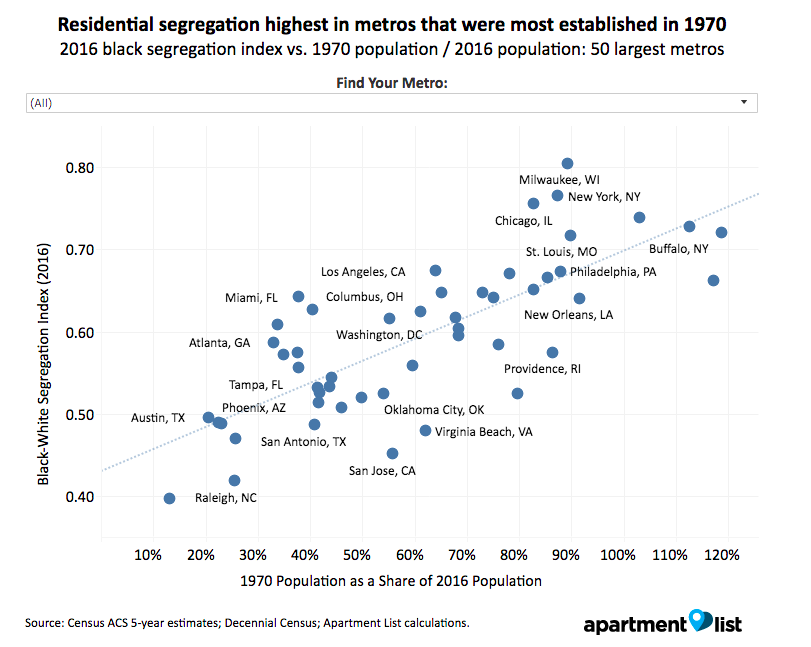What City Observatory did this week
1. Growth in the center. A new report from New York City’s Office of Planning graphically demonstrates the growing centralization of people and economic activity in the nation’s largest metropolitan area. We highlight two sets of dot density maps that show the overall change in population in the New York region, and the shifting location patterns of prime age (25 to 54 year old) adults. The city’s much heralded population growth has powered the overall expansion of the region since 2010; more than 60 percent of population growth has occurred in the five boroughs of New York City, while some suburbs have recorded population declines. The pattern is even more striking for prime-age adults. They’ve increased dramatically in central locations in the city, especially in neighborhoods with strong rail transit. Meanwhile, there’s been widespread decline of prime age workers in the suburbs. What’s happening in New York is indicative of the shift to a city-centered knowledge based economy, and the growing demand for urban amenities, which, as we’ve pointed out at City Observatory, is producing a shortage of cities.
2. The persistence of racial segregation. Rentonomics economist Chris Salviati has an illuminating new report calculating the segregation rates of the nation’s largest metropolitan areas. Using the latest 2012-2016 American Community Survey data, he computes the dissimilarity index for metro areas. You can see where your metro area ranks compared to others. In addition, this analysis shows a strong correlation between persistent racial segregation and slow or stagnant metropolitan population growth. Slow-growing, older industrial cities consistently have higher segregation rates than faster growing metros. This finding ties in with recent social science research that shows that African-Americans moving to a different metropolitan area, are much more likely to move to integrated neighborhoods than those who make within-metro area moves.
Must read
1. Driverless buses: Not so fast? Despite all the hype about autonomous vehicles, and the well-publicized driverless passenger car testing ongoing around the country, Alon Levy, writing at The American Prospect is skeptical that we’ll see driverless transit buses anytime soon. Levy correctly points out that driverless bus demonstrations are very much in their infancy, restricted to low speed trials in carefully controlled situations. Most of his critique is equally, if not more applicable to autonomous private vehicles, with concerns about their safety and their ability to reliably recognize pedestrians and cyclists and cope with changing road conditions. Still, it’s worth noting that autonomous transit vehicles would basically need “Level 4” automation (the ability to drive autonomously on pre-determined fixed routes) rather than “Level 5” (the ability to drive pretty much anywhere, anytime). Given the high cost of transit vehicle operators, there are strong incentives to figure out how to automate transit vehicles.
2. The limits of LEED buildings. CityLab has a retrospective on the nearly 25-year history of the LEED building standards promoted by the US Green Building Council. They were founded out of a grass roots movement by environmentally concerned architects, and have grown since then to be a widely known and promoted standard for new construction. Despite LEED’s popularity, there are still strong reasons to question its efficacy. Critics have pointed out flaws the USGBC’s claims that these buildings save energy, and even the Council admits its done a poor job collecting reliable data to illustrate savings. Just as important, as we’ve pointed out at City Observatory, LEED standards mostly turn a blind-eye to locational issues and the transportation costs embedded in a building’s –which is why we can have, with little sense of irony, a LEED-certified parking garage (at a renewable energy research laboratory, no less). While LEED has no doubt prompted innovation and promoted awareness of building energy use, it falls well short of being policy that’s fully aligned with saving energy and reducing carbon emissions.
3. Unbundling parking prices. Parking is expensive. It only seems to be free because the cost of parking gets bundled with other prices we pay. This is doubly discriminatory: First, it means that those who don’t use parking (like shoppers who walk, cycle or take transit to a store that maintains an expensive parking lot) end up subsidizing those who drive. Second, it creates more incentives to drive, and disincentives to use cleaner, greener modes of transportation. Little surprise then, than one of the best ways to fix this problem is to un-bundle parking prices. Mobility Lab highlights a new report from Arlington Virginia on the impacts of doing just that. Separating parking charges from apartment rents allows those who don’t own cars to get more affordable housing.
New Ideas
Where murders are solved, and where they’re not. The Washington Post has a terrific piece of data journalism examining the geographic patterns of homicides, with a focus on where police solve crimes and where they don’t. Nationally, only about half of all homicides are solved, but the geographic pattern of unsolved murders is hardly random. Unsolved crimes tend to be disproportionately clustered in certain neighborhoods, and the Post’s analysis shows that those neighborhoods are disproportionately poor and either African-American or Latino. A key factor in solving crimes is whether there are strong relationships between the community and the police, and in many of these neighborhoods, there aren’t. This effect is amplified where gangs are prevalent, as the threat of retaliation for cooperating with the police makes in less likely witnesses will come forward. The post piece has on-line maps of solved and unsolved crimes in 50 large cities around the country, and also has a downloadable database of more than 50,000 homicides.
In the news
The Memphis Commercial-Appeal recounted our analysis of the perils and pitfalls of city-supported aquariums: “When it comes to aquarium success, Memphis will need more than public money.”
Archinect–the online magazine of architecture news–drew its reader’s attention to the same subject in “The risky business of city aquariums.”




